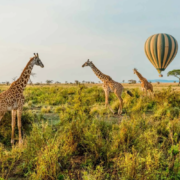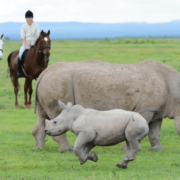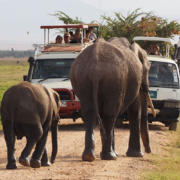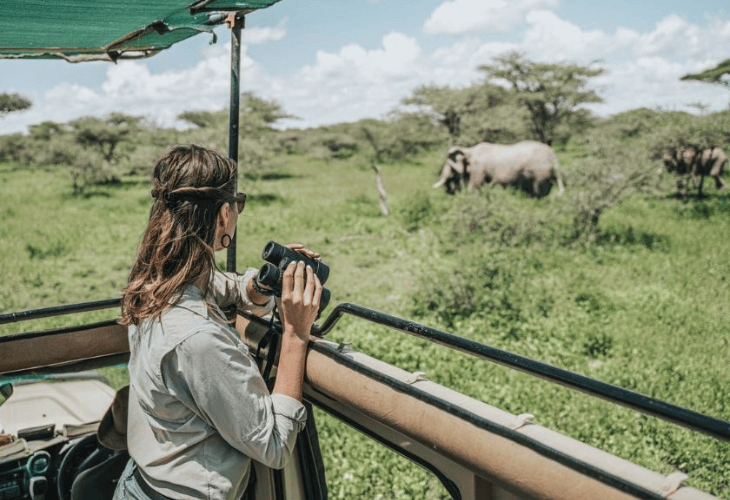
Eco-Friendly Safari Adventures
Introduction
It can be thrilling to hover in the air, observing the decent altitudes that can assist you in capturing the Great Migration drama around the Maasai Mara. Not to mention the breathtaking views of the Big Five in Amboseli or Serengeti National Parks. So, why implement eco-friendly safari adventures?
Eco-friendly tourism is the way to go if you want to sustain and preserve rich ecosystems. For instance, Kenya has an enviable biodiversity, including birds and the Big Five, which requires proper care to allow future generations to tap into this industry.
For this reason, eco-friendly safaris reinforce mechanisms to lower environmental impacts and promote wildlife conservation, bringing more benefits to the local communities.
Preserving wildlife is an economic choice because tourism accounts for 10% of Kenya’s GDP.
Responsible tourism is needed since millions of visitors come to Kenya to exploit our biodiversity, including accessing endangered species. For the nation to continue enjoying foreign income from these visitors, efforts must be made to preserve these habitats for sustenance.
Daylight Adventures aims to inform you about the benefits of eco-friendly tourism and how it sensitizes locals and tourists to adhere to preservation best practices. In the end, stakeholders should understand how to conserve natural heritage as they transfer it to future generations.

Tourist taking strategic photos at a safe distance
What does Eco-friendly Safaris entail?
Eco-friendly tourism is a deliberate action that involves initiatives to promote responsible travel experiences while focusing on minimizing environmental tourism. Such actions include respecting wildlife and lowering carbon emissions in the air.
Such practices ensure that ecosystems and landscapes remain intact as travelers exploit these areas without damaging future generations.
Before eco-friendly tourism became active, visitors could reduce their adventure to a hunting expedition, thereby causing damage to the remaining species. Later, there was a shift in focus, and the government implemented acts to preserve the environment by prohibiting certain actions that could endanger the ecosystems.
Conservationists led the need for change and introduced a different form of tourism, reduced to photographic safaris. Here, they shifted the actions from exploitation to preservation to enhance sustainability.
Conventional Versus Eco-Friendly Safaris
Convection safaris involve a range of damages while exploiting resources. These could include off-road driving that damages habitats or puts pressure on systems.
Eco-friendly safaris value sustainability with preservation efforts such as using solar energy, less carbon emission, observing wildlife from a safe distance to prevent disturbances, and observing fragile habitats.
Role of Sustainability and Conservation
Modern safari tourism needs to implement checks and balances to lower its negative impact on the environment. For sustainability, Daylight Adventures trained its operators to observe eco-friendly practices such as implementing waste management programs, water conservation, and using clean and renewable energy.
Sustainable efforts include limiting habitat degradation, lowering carbon footprints, and creating pristine safari destinations. These efforts ensure that visitors exploit natural resources without contributing to their depletion.
Daylight Adventures partners with wildlife organizations and national parks to protect endangered species like rhinos, lions, and elephants. The company allocates some revenue towards conservation initiatives for the long-term protection of ecosystems.
Some threats to these conservation measures are habitat loss, illegal wildlife trade, and poaching. Once they donate these funds to a wildlife agency, it uses them to combat poaching and restore and monitor habitats for future engagements.
Economic benefits
- Employment: Eco-friendly safaris directly benefit the local community by creating employment opportunities. For example, tour companies like Daylight Adventures employ the local community in various ranks, such as tour guides, tour operators, hospitality staff, and more. These jobs offer stable income while contributing to the region’s economic stability.
- Skills: Many safari-based companies engage the local communities with projects that promote the natural environment. For example, the co-lodges can partner with Samburus to tap traditional knowledge into advanced conservation strategies. Doing so ensures that you tap old strategies that the community knows and empower them with modern skills to help conserve the environment.
- Business: Tourists participate in cultural visits, accessing local items made by locals, such as crafts, thereby empowering the local business people economically. Since the community will have an alternative income source, they will avoid engaging in harmful activities like poaching. Such efforts promote human development while conserving the environment.
Sustainable Safari Lodging and Camps
Eco-friendly safaris are why deliberate initiatives have been taken to promote sustainable safari lodgings and camps. These luxurious resources have mechanisms to minimize environmental impacts while offering an unforgettable encounter to the users.
Mostly, these facilities are in remote rural areas where they offer you a chance to behold stunning landscapes and wildlife, enabling visitors to indulge in nature responsibly. These lodges uphold water conservation, energy efficiency, and waste management. Let’s tackle each item separately:
Energy Efficiency
Many lodges use clean and renewable energy sources to reduce environmental hazards. For example, they adopt solar energy to minimize their carbon footprints in the air, making them independent from the national grid.
They install solar energy plants to use them for various activities such as refrigeration or lighting, reducing reliance on fossil energy greatly. As a way of supporting clean energy, some lodges have wind turbines to promote the use of clean energy.
Moreover, eco-friendly elements incorporated into the construction of these lodges, such as bamboo, natural stone, or recycled wood, reduce the impacts of damage during construction. The good news is that these locally available materials blend with the natural environment, making them attractive.
Water Conservation
Water is a precious commodity that sustains plants and animals, so minimizing wastage is a step forward. Several lodges, especially in arid and semi-arid regions, employ strategies that revolve around conserving water from their sources for future use without compromising quality.
Most of these accommodation facilities have rain harvesting facilities where they collect and store this rainwater for consumption in all operations that require these precious commodities.
Similarly, eco camps have water treatment plants that promote reuse in different scenarios, such as irrigation.
Moreover, these lodges use eco-friendly low-flow faucets to reduce water consumption, which is still a saving design. Additionally, the policy of these guest houses urges the use of water sparingly, which is a keen measure to check on the water supply.
Waste Management
Eco-friendly safaris create a ripple effect that prompts eco camps to enforce some initiatives that lead to better waste management methods. What does this imply? Well, lodges try to minimize the amount of waste in landfills.
For instance, they can minimize non-recyclable wastes through sourcing and packaging while composting organic wastes and later using them to upgrade garden fertility.
Various lodges and camps ensure zero-waste operations by compositing, recycling, or reusing materials. Some eco-friendly initiatives include avoiding single-use plastics and encouraging refillable water bottles for hydration.
Furthermore, these lodges encourage the use of biodegradable toiletries, reducing the impact on the environment. The lodges also encourage visitors to follow proper environmental conservation guidelines during their stay.
Wildlife Protection Initiatives
Implementing eco-friendly tourism is a giant leap toward wildlife protection and preservation because it encourages tourists to engage in activities that conserve the ecosystem and protect endangered species.
Many African countries are implementing eco-friendly practices thanks to eco-tourism funding from conservationist organizations. So, how does eco-friendly tourism contribute to wildlife conservation?
Eco-tourism plays a central role in wildlife conservation in multiple ways. First, different safari companies, such as Daylight Adventures, partner with non-governmental organizations and wildlife reserves to empower conservation projects.
They offer these funds to support the government in reducing activities that could endanger the environment, such as poaching. Furthermore, the government channels these funds to research programs and sensitizes the stakeholders to better efforts that could lead to a sustainable environment.
Furthermore, eco-friendly safaris encourage implementing initiatives to prevent environmental damage, such as avoiding single-use plastics in fragile ecosystems.
Cooperation Between Conservation Operators and Safari Operators
Poaching is one of the greatest threats to wildlife conservation because it involves ending the lives of some of these strategic species and minimizing their population. This illegal hunting spree targets some of the endangered species like rhinos or elephants.
The good news is that conservation operators may fund programs to preserve these animals by activating anti-poaching patrol and animal tracking programs. They track via satellite signals, drones, or using some of the trained personnel to prevent poaching.
Animal tracking programs include monitoring the movements and behaviors of affected animals, such as elephants and rhinos, to understand their needs and threats. These technologies enable trackers to create corridors for wildlife to locate safe territories and minimize human-wildlife conflict.
Protecting Endangered Species
Without protecting endangered species, there will be nothing to transfer to the future generation, killing the whole industry. Funding for conservation initiatives is critical for the realization of this dream. Some parks introduce eco-friendly fees, a bright initiative for conserving species like lions, rhinos, and elephants.
For example, Ol Pejeta Conservancy implements a rhino breeding program in Kenya thanks to eco-tourism revenue. Furthermore, they sensitize tourists about these endangered species to expand their understanding of why more funds are needed to protect these threatened wildlife.
Mitigating Human-Wildlife Conflict
Human-wildlife conflict occurs when wildlife access human settlement areas and destroy their properties, such as crops and livestock. In response, retaliatory killing occurs, which threatens endangered species. The government takes initiatives to create wildlife corridors and implement educational programs that promote coexistence.
Many lodges and camps partner with the local community to work on initiatives that deter elephants from certain actions. For example, they encourage the local farmers to begin a beekeeping program, which keeps the elephants away from human territories.
Successful Conservation Projects
Eco-friendly tourism is a powerful move that has led to the emergence of certain conservation projects that are recording remarkable milestones.
We begin with Lewa Wildlife Conservancy, a notable rhino sanctuary that works to enhance both the white and black rhino populations. This conservancy program is successful due to partnering with donors who deliver funds for habitat restoration and anti-poaching efforts.
Besides, the Amboseli Elephant Research Project partners with safari operators to monitor and track the elephant population. They use such data to demarcate safe zones where these majestic creatures can live comfortably.
As if that were not enough, there is the Mara Predator Conservation Program, an initiative to protect carnivores such as Lions in the Maasai Mara. The program involves sensitizing the local community to reduce human-wildlife conflict and keep the predator population on an upward trend.
Sustainable Dining on Safari
Many camps and lodges are supporting culinary action that leads to a reduction in environmental degradation. They are implementing sustainable practices such as minimal wastage, use of local ingredients, and cultural enrichment through cuisine to protect the natural ecosystems. Here are a few steps that support sustenance at camps and lodges:
a) Farm-to-Table Experiences
Many camps and lodges are now developing their own gardens where they grow herbs, fruits, and vegetables to minimize the carbon footprints from the supply chain. Since they will be nurturing these plants, they will follow the right procedures to ensure they get natural ingredients that make them not only flavorful but nutritious.
Doing so ensures that they only invest in fresh products, thereby retaining the freshest ingredients from these supplies. Furthermore, they outsource fresh supplies from the local community, such as sustainably sourced fish and fruits, which is an economic advantage to the local traders.
For example, Maasai Mara lodges source their meat and dairy products from the Maasai community, which creates a sustainable relationship for economic growth. Furthermore, dining on local products enables guests to taste local flavors, reflecting regional biodiversity.
b) Learning about Local Cuisine
Lodges and camps allow visitors to participate in interactive classes to learn about cooking local delicacies such as nyama choma and sukuma wiki. These classes showcase traditional cuisines featuring local ingredients.
When visitors access the local market to purchase raw food items, it becomes an opportunity to learn and know their users. It is also a chance to understand how people connect with food.
Furthermore, the local chefs used that moment as a storytelling session, explaining some mysteries of how art was passed down from ancestors to successive generations.
The use of local delicacies is a step forward as it reduces the carbon footprint of imported items. Some lodges root for products within a 100km radius, ensuring that they remain fresh and sustainable at the supply stage.
c) Bush Meals and Picnics
Picture this: Taking your meal in the bush while surrounded by impressive natural phenomena such as stunning wildlife and landscapes and including sustainable practices. Chefs use local ingredients to prepare meals while upholding eco-friendly practices.
Besides, they serve these meals on biodegradable plates to minimize environmental impact. They prohibit the use of single-use plastic; instead, they use palm leaf plates and bamboo cutlery.
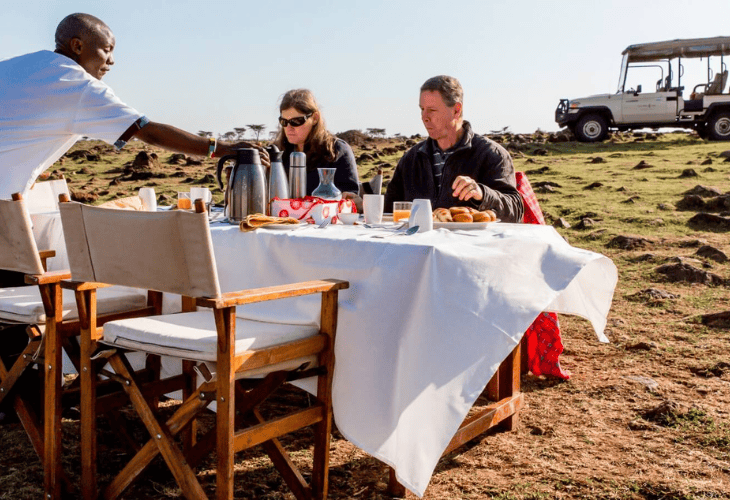
Bush meal picnic in the plains of Maasai Mara
Bush meals offer guests a chance to taste local flavors prepared by traditional means using indigenous ingredients. Taking your bush meal under an acacia tree in the Savannah plains is an adventure of its kind.
d) Reducing Food Waste
Sustainable safari also minimizes food wastage on the dining table and the kitchen. For instance, campsites and lodges inquire about the number of guests so that they can prepare food based on the right number to prevent wastage.
Moreover, many eateries are now avoiding the buffet-style meal. Instead, they are implementing the la carte option to reduce wastage and leftovers. In case there are leftovers, they will composite them and later reuse the manure to enrich local gardens that support vegetables or fruits.
Furthermore, more efforts are available to eliminate food wastage, including distributing the remaining food to the local community. Such a practice strengthens local ties with the community from a social perspective.
Wildlife Encounters
Eco-friendly safaris promote responsible tourism by sensitizing visitors to engage in ethical practices that preserve natural resources. To some, watching the Big Five or witnessing the Great Migration in Serengeti is a lifetime opportunity. For that reason, there should be protocols that guide visitors to ensure minimal damage happens during their encounter with wildlife, as suggested below:
a) Ethical Animal Viewing Practices
The first eco-friendly principle in wildlife encounters with visitors is educating them on retaining a safe distance to prevent wildlife disturbance. Furthermore, they should use eco-friendly vehicles that have minimal impact on the surroundings, such as minimal noise and less carbon emissions.
Rangers and guides have enough skills to educate visitors about animal behaviors. They will equip them with skills to interpret signs of agitation and stress and adjust to the condition accordingly. They need this knowledge so that they do not interfere with critical moments for this wildlife, such as caring for the young ones, hunting, or mating.
Furthermore, some eco-friendly practices discourage any form of captive animal interaction, such as riding on an elephant’s back. Instead, they encourage tourists to view wildlife in their natural settings without altering their schedule, which is a long-term species protection measure.
b) Bird Watching Expeditions
Kenya boasts of over 1000 bird species ranging from eagles to parrots in large numbers. The good news is that Daylight Adventures organizes trips for visitors to strategic places to view and capture fascinating moments of these birds, led by experienced guides who better understand these species.
They know perfect habitats where you can view and take videos without disturbing them, such as savannas, wetlands, and forests. Furthermore, they will also take you to where migratory birds dwell for a season before retreating to Asia and Europe.
These birds typically have roles in the ecosystem. For example, they are seed dispensers, scavengers, and pollinators. As a visitor, you should avoid acting in a manner that could interfere with their routine life since these birds play a critical role in the ecological balance.
While visiting, the guides will expand your understanding and teach you that these birds are critical in sustaining fauna and flora in that region.
c) Popular Species
Kenya is home to some of the most coveted wildlife in the world, from elephants to lions to cheetahs, which are considered the most dangerous to hunt. Nowadays, they play a central role in the tourist attraction.
Rhino is a unique species that is in danger of extinction. Thankfully, many eco-friendly safari companies, like Daylight Adventures, are now partnering with Rhino conservancies to ensure that this coveted species is safe from poaching.
Other notable species are zebras, hippos, giraffes, and lions, which survive in woodlands, wetlands, and savannahs. One encounter that offers unparalleled viewing opportunities is the Great Migration in Maasai Mara, where visitors witness thousands of wildebeests and zebras crossing to Serengeti National Park for survival.
Apart from larger animals, smaller species also form a great deal of tourist attraction. These may include hyenas or jackals within the ecosystem. Tour guides sensitize guests to appreciate the small animals, ranging from insects to the largest mammals within the ecosystems, and apply conservation principles to sustain their livelihoods.
d) Night Safaris and Stargazing
Going on night safaris and witnessing Africa’s wilderness for a spectacular view of the darkness can be interesting. Certain animals, especially predators like hyenas, lions, and leopards, have a routine of becoming active as the darkness grips them.
Daylight Adventures offers guided night safaris in vehicles equipped with low-impact light to uncover rare behaviors during the day.
Furthermore, stargazing is another way for visitors to observe the Milky Way in clear skies. It becomes easy to spot shooting stars and constellations, and experts will share their knowledge of the mystery behind these stars as you gaze into the clear sky while in the midst of the serene wilderness; you can also take photos and videos for a lifetime experience.
Eco-Activities beyond Wildlife
Several activities beyond wildlife enable tourists to participate in sustainable practices when connecting with nature, such as:
a) Guided Nature Walks
Daylight Adventures supports guided nature walks and offers visitors an intimate connection with nature during safaris. The role of nature walks is to capture as many details as possible as you interact with your ecosystem on foot closely.
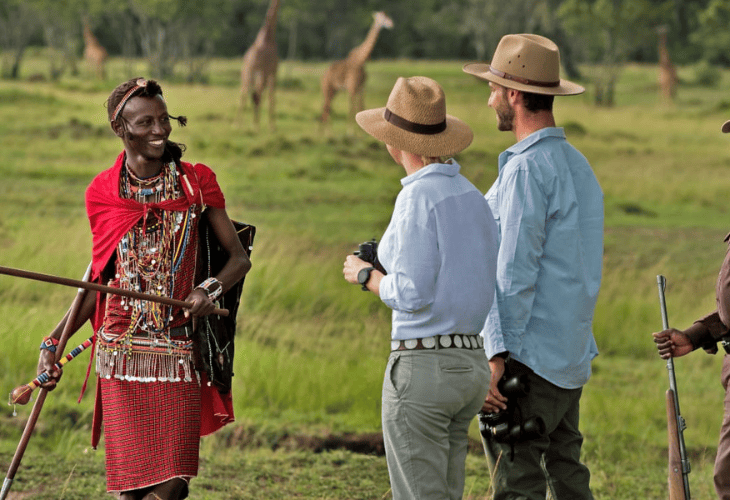
Guided nature walks in Maasai Mara
Besides, the experts on the trip will guide you on how to appreciate geology, fauna, and flora. They will help you understand how the local vegetation supports mammals and help you observe insects and footprints. Typically, walking safaris are quieter, allowing visitors to observe environmental impacts.
b) Plant Identification Tours
Plant life is an aspect that many safaris overlook; however, there is more than meets the eye that offers a thrilling experience. The role of such trips is to help visitors understand the part that plants play in the ecosystem. For instance, plants are elements that offer shelter and food to wildlife while preventing soil erosion and landslides.
The experts help visitors identify plants in their natural form that have different values, whether medicinal or cooking. This learning experience helps tourists appreciate fauna in relation to flora.
c) Volunteer Opportunities
Volunteer programs are one aspect of conservation efforts. Some lodges and camps allow guests to participate in volunteer programs such as community education projects or wildlife monitoring.
Such programs offer an enriching experience where participants give back and gain a deeper understanding of locals’ hurdles in protecting wildlife. These make the safaris have a great impact on promoting nature.
d) Landscape Photography Workshops
If you want to capture the beauty of Africa, here is the opportunity. The only difference is that it will be eco-conscious photography. You will attend these workshops driven by experts who will inject skills in you on the best practices of taking photographs of cultural scenes, wildlife, and landscapes while respecting the environment.
For example, you will get the right tips for photographing animals without disrupting their habitat. Furthermore, you will know how to tread on delicate habitats without causing damage.
In Conclusion
Africa’s wilderness hosts multiple species of mammals, reptiles, and birds, which are sources of tourist attraction throughout the season.
Notably, human activities such as poaching have compromised the existence of certain animals facing the threat of extinction. In response, many governments have implemented laws that support conservation to preserve these assets for future generations.
Conservation measures require shifting your focus on the norm and implementing mitigation measures to prevent further environmental damage.
For instance, Daylight Adventures supports the use of renewable sources of energy and lowers wastage to minimize environmental impact.
Tourism is now an avenue of environmental preservation through eco-friendly safaris. Experts now equip guests with the knowledge to apply and maintain eco-friendly practices such as guided nature walks or plant identification tours.
Moreover, lodges and camps are now enforcing sustainable measures to prevent environmental degradation through irresponsible human activities. Kenya is now at the forefront of protecting the environment for economic prosperity. These practices encourage tourists to respect the natural world and allow it to thrive for future generations.
Want a safari tailored just for you? Inquire now for a personalized safari experience designed to match your unique interests and needs with Daylight Adventures!


